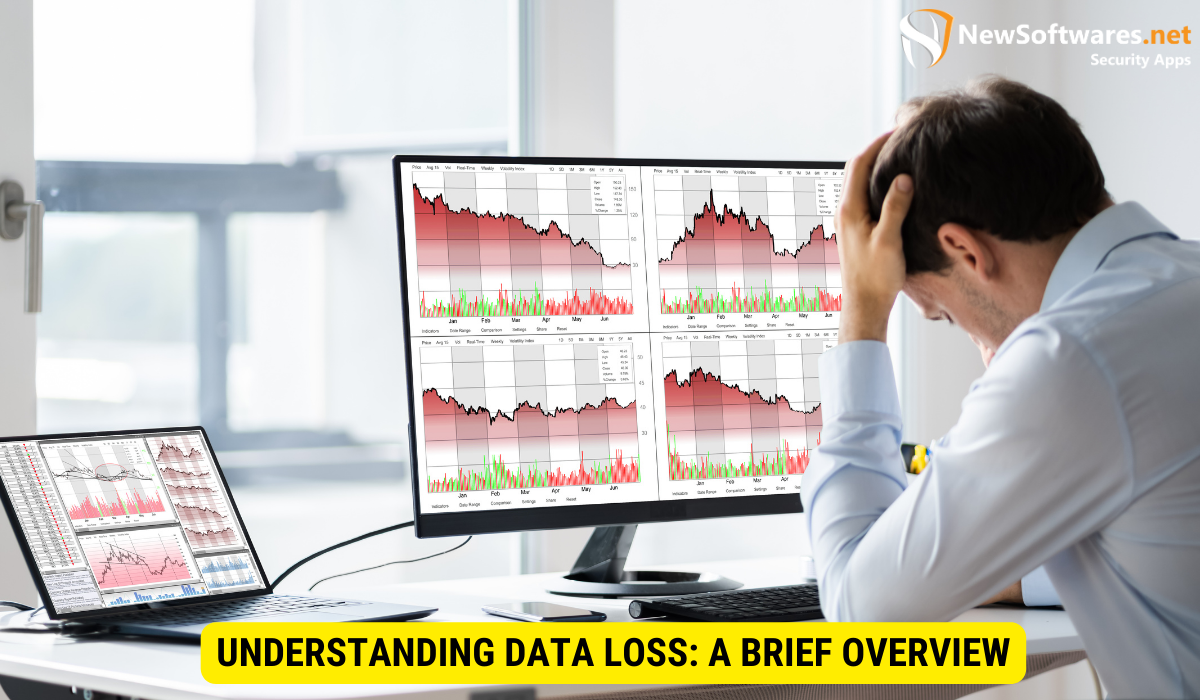Two vital security measures for enhancing data loss prevention are regular data backups, which ensure recovery of lost or corrupted data, and implementing strong access controls to restrict data access based on user roles and responsibilities.
Data loss prevention (DLP) is a critical aspect of any organization’s cybersecurity strategy. As technology continues to advance and data becomes increasingly valuable, it is more important than ever to protect sensitive information from loss or unauthorized access. I will explore two vital security measures that can enhance data loss prevention efforts: regular data backups and implementing strong access controls.
Understanding Data Loss: A Brief Overview

Data loss refers to the unintentional or accidental destruction, alteration, or corruption of data, rendering it inaccessible or unusable. The consequences of data loss can be severe, leading to financial loss, reputation damage, legal implications, and a loss of customer trust. Understanding the causes and consequences of data loss is essential in developing an effective data loss prevention strategy.
Data loss is a pervasive issue in today’s digital landscape. With the increasing reliance on technology and the exponential growth of data, organizations must be prepared to mitigate the risks associated with data loss. By understanding the intricacies of data loss, organizations can proactively implement measures to protect their valuable information.
The Consequences of Data Loss
When sensitive data is lost or compromised, organizations can face significant consequences. Financially, data loss can result in loss of revenue, regulatory fines, and potential lawsuits. The financial impact can be devastating, especially for small businesses that may not have the resources to recover from such setbacks.
From a reputational standpoint, organizations may suffer a loss of customer trust, damaging their brand image. In today’s interconnected world, news of data breaches spreads quickly, and customers are becoming increasingly cautious about sharing their personal information with companies that have a history of data loss incidents. Rebuilding trust can be a long and arduous process, requiring extensive efforts in transparency and security enhancement.
Additionally, data loss can also lead to a breach of compliance requirements and result in legal ramifications. Many industries have strict regulations regarding the protection of sensitive data, such as healthcare with the Health Insurance Portability and Accountability Act (HIPAA) or finance with the Payment Card Industry Data Security Standard (PCI DSS). Failure to comply with these regulations can result in hefty fines and legal penalties.
Common Causes of Data Loss
Data loss can occur due to a variety of factors. Human error, such as accidental deletion or mishandling of data, is a leading cause. Despite advancements in technology, humans remain the weakest link in data security. Simple mistakes, such as clicking on a malicious link or failing to properly back up data, can have disastrous consequences.
Cybersecurity incidents are another significant cause of data loss. Malware attacks, hacking, or phishing attempts can infiltrate systems and compromise sensitive data. Cybercriminals are constantly evolving their tactics, making it crucial for organizations to stay vigilant and employ robust security measures to protect against these threats.
Hardware failure is yet another cause of data loss. Hard drives can fail unexpectedly, resulting in the loss of stored data. Natural disasters, such as fires or floods, can also damage physical hardware and render data inaccessible. Power outages and software glitches can cause data corruption or loss if systems are not properly configured or maintained.
Understanding the common causes of data loss is the first step in developing a comprehensive data loss prevention strategy. By identifying the vulnerabilities within an organization’s infrastructure, appropriate safeguards can be implemented to mitigate the risks and minimize the impact of potential data loss incidents.
The Importance of Data Loss Prevention
Data loss prevention is crucial for organizations of all sizes and industries. By proactively safeguarding sensitive data, organizations can mitigate the risks associated with data loss and protect their valuable assets. In addition to financial and legal implications, data loss can have a significant impact on customer trust, which is crucial for maintaining a successful business.
The Role of Data Loss Prevention in Business
Data loss prevention plays a vital role in maintaining the integrity and confidentiality of sensitive business information. It helps protect intellectual property, trade secrets, financial records, and customer data from unauthorized access or accidental disclosure. By implementing robust data loss prevention measures, businesses can ensure compliance with industry regulations and build customer trust.
The Impact of Data Loss Prevention on Customer Trust
Customers value their privacy and expect organizations to handle their data with care. Data breaches can erode customer trust and loyalty, leading to potential customer churn and negative publicity. On the other hand, effective data loss prevention measures demonstrate a commitment to data security and can enhance customer trust, setting an organization apart from its competitors.
First Vital Security Measure: Regular Data Backups
Regular data backups are an essential component of data loss prevention. By creating copies of important data and storing them securely, organizations can restore their systems and recover lost or corrupted data in the event of an incident. Implementing a comprehensive data backup strategy requires careful consideration of the backup process and choosing the right backup solution.
The Process of Data Backups
The data backup process involves identifying critical data, determining the frequency and method of backup, and storing the backups securely. Organizations should consider automating the backup process to ensure consistency and reliability. It is important to create backup schedules that align with the data’s value and update frequency, ensuring that all critical data is protected.
Choosing the Right Backup Solution
When selecting a backup solution, organizations need to consider factors such as scalability, reliability, security, and ease of use. Cloud-based backup solutions offer advantages such as automated backups, off-site storage, and easy scalability. On-premises backup solutions provide organizations with more control over their data but may require additional resources for maintenance and security.
Second Vital Security Measure: Implementing Strong Access Controls
Implementing strong access controls is another crucial aspect of data loss prevention. Access controls involve granting users access privileges based on their roles and responsibilities within the organization. By enforcing stringent access controls, organizations can minimize the risk of unauthorized access, accidental data leakage, and insider threats.
The Basics of Access Control
Access controls involve authentication, authorization, and accountability. Authentication verifies the identity of users, while authorization determines the access privileges granted to each user. Accountability ensures that user actions are traceable and accountable. By implementing a robust access control framework, organizations can enforce the principle of least privilege, limiting access to sensitive data to only those who need it.
Best Practices for Implementing Access Controls
- Regularly review and update access control policies and procedures to adapt to changing threats and evolving business needs.
- Implement multi-factor authentication to strengthen user verification.
- Enforce strong password policies, including regularly changing passwords and using complex passwords.
- Segment networks to segregate sensitive data from less critical systems.
- Regularly monitor and audit user activities to detect any suspicious behavior or policy violations.
Beyond the Two Vital Security Measures: Additional Strategies

In addition to regular data backups and strong access controls, organizations can employ additional strategies to enhance data loss prevention efforts.
The Role of Encryption in Data Loss Prevention
Encryption is a powerful tool for protecting data both at rest and in transit. By converting data into an unreadable format, encryption ensures that even if the data falls into the wrong hands, it remains unintelligible. Organizations should consider implementing encryption technologies to protect sensitive data, especially when it is stored in the cloud or transmitted over networks.
The Importance of Regular Security Audits
Regular security audits help organizations identify vulnerabilities, evaluate the effectiveness of security controls, and ensure compliance with industry standards and regulations. By conducting comprehensive security audits, organizations can proactively identify potential weaknesses in their data loss prevention measures and take corrective actions.
Key Takeaways
- Understand the consequences and causes of data loss to develop an effective data loss prevention strategy.
- Regular data backups are essential for recovering lost or corrupted data.
- Implementing strong access controls minimizes the risk of unauthorized access and accidental data leakage.
- Encryption protects data both at rest and in transit, enhancing data loss prevention efforts.
- Regular security audits help identify vulnerabilities and improve data loss prevention measures.
FAQs
-
Why is data loss prevention important?
Data loss prevention is important because it helps protect sensitive information from loss, unauthorized access, and accidental disclosure. It safeguards organizations’ reputation, customer trust, and financial well-being.
-
How often should data backups be performed?
The frequency of data backups depends on the organization’s data value and update frequency. Critical data should be backed up frequently, while less critical data may require less frequent backups.
-
What are access controls?
Access controls involve granting users access privileges based on their roles and responsibilities. These controls limit data access to only those who need it, reducing the risk of unauthorized access and accidental data leakage.
-
Can encryption prevent all data breaches?
While encryption can significantly enhance data security, it is not foolproof. However, implementing encryption technologies ensures that even if data is compromised, it remains unreadable and unintelligible to unauthorized individuals.
-
How often should security audits be conducted?
Security audits should be conducted regularly to identify vulnerabilities, evaluate the effectiveness of security controls, and ensure compliance. The frequency of security audits may vary depending on industry regulations and business requirements.
Conclusion
Data loss prevention is a critical aspect of cybersecurity, and organizations must proactively implement measures to protect sensitive data. Regular data backups and implementing strong access controls are two vital security measures that significantly enhance data loss prevention efforts. Additionally, leveraging encryption technologies and conducting regular security audits further strengthen an organization’s ability to prevent data loss and protect its valuable assets. By prioritizing data loss prevention, organizations can safeguard their reputation, maintain customer trust, and mitigate the financial and legal implications of data breaches.
